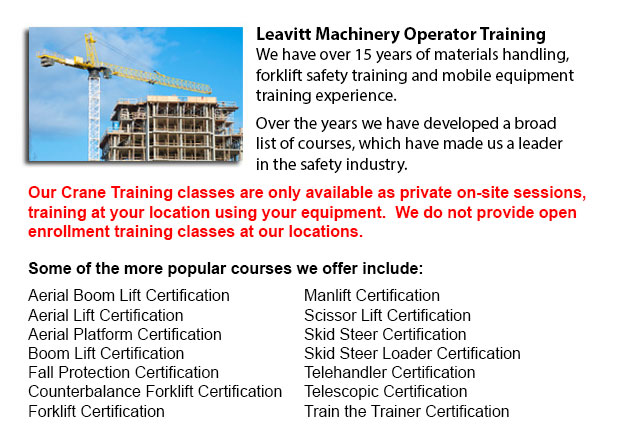
Overhead Crane Safety Training Kamloops - Overhead crane safety training equips operators with knowledge and skills about crane safety precautions, materials handling, accident avoidance, and machine and stock protection. Trainees would learn the kinds of overhead cranes, their capabilities and their uses in various industry environments. For operators who are licensed and trained, the shift in liability moves from the company to the operator. Therefore, the course emphasizes individual operator tasks.
Overhead crane safety training instructs operators in the correct methods for performing checks. Two kinds of pre-shift inspection are the walk-around inspection and the in-depth inspection. These are vital every day routines that must be logged. Properly recorded pre-shift inspections help to protect the company from liability in the event of an accident. Pre-shift inspections likewise prevent expensive repairs, accidents and damage. Operators learn how to designate a particular person to perform checks, how to report problems, and how to maintain the log book.
Inspections should be done regularly and documented right. The following must checked while watching for common problems: hooks for cracks, increases in the throat opening, hoist ropes for corrosion, degree of twist, worn wires, loss of diameter, broken wires, kinks and bird caging, chains for gouges and nicks, heat and chemical damage, twists, cracks and corrosion, excessive wear, distortion, stretching, pits, damage from extreme heat.
Operators learn right rigging methods in this course. Rigging involves understanding the manufacturer's data plate, determining the weight of materials to be lifted, choosing the gear, and using safe practices to secure the load. The program cover in detail the following: safe working loads, and the capacities of ropes, chains, slings, hooks and shackles.
It is important to understand who could utilize the cranes at your facility, the job's physical requirements, and operator credentials needed for specialized job and permits. Safety should be prioritized when operating near pedestrian traffic.
Safe crane operation includes responsibilities such as undertaking visual inspections, checking for hydraulic leaks, checking the safety guards, testing the controls, examining the hoist rope and hook, limit switches and braking mechanisms. Right reporting procedures are critical. These topics are all included in depth in the course.
Proper lifting and moving methods with cranes and hoists are included in the program. Operators would become skilled in hand signals. Training involves how to raise the load, attach the load, abort a lift, set the load and unhook the slings.
The steps involved with moving the load, consists of: starting and stopping procedures, guiding and controlling the load, working with signals and observing working conditions. In case of power failures, the operator would have to know how to proceed. The course covers methods for removing the slings and lowering the load, parking the crane, storage equipment, and securing an indoor and outdoor crane.
-
Forklift Training Course Kamloops
Forklift Training Course Kamloops - CSA and OSHA establish criteria for forklift safety training that meets current standards and regulations. Anybody planning to use a forklift is needed to successfully complete safety training prior to utilizing an... More -
Forklift Training Program Kamloops
Forklift Training Program Kamloops - The forklift is a common powered industrial vehicle which is in wide use these days. They are occasionally called lift trucks, jitneys or hi los. A departments store will use the forklift in order to unload and lo... More -
Aerial Lift Training Kamloops
Aerial Lift Training Kamloops - The mechanized access platform known as an aerial work platform is a machinery which provides access to places that are otherwise inaccessible to people and other machine. Likewise called an elevating work platform or... More -
Forklift Training School Kamloops
Forklift Training School Kamloops - Forklift Training School - CSA and OSHA establish criteria for forklift safety training which meets existing standards and regulations. Anybody planning to use a forklift is needed to successfully complete safety t... More -
Heavy Equipment Training Courses Kamloops
Heavy Equipment Training Courses Kamloops - When choosing a heavy equipment operator course, the initial step must be to determine the capacity in which you would be working with heavy machines. You could find the correct course to teach you how to o... More -
Heavy Equipment Training School Kamloops
Heavy Equipment Training School Kamloops - HEO or also known as the heavy equipment operator courses would provide you with the skills and knowledge required in order to enter the workforce as an entry level heavy machine operator. In this 12 week co... More -
Telehandler Operator Training Kamloops
Telehandler Operator Training Kamloops - Telescopic handler Forklifts or telehandler forklifts are common industrial equipment found in numerous construction industry environment. The telehandler is a helpful machinery and makes for a valuable tool w... More -
Telehandler License Kamloops
Telehandler License Kamloops - A telehandler or telescopic handler is a machine which is frequently utilized in agricultural and industrial applications. It has a similar appearance to a forklift and even works in a similar manner, though, the teleha... More

Forklift Training Kamloops
TOLL FREE: 1-888-254-6157
Kamloops, British Columbia
forklifttrainingkamloops.com
Email Us
About Us


